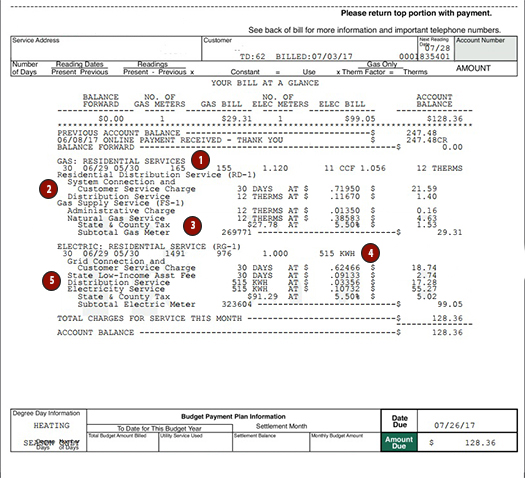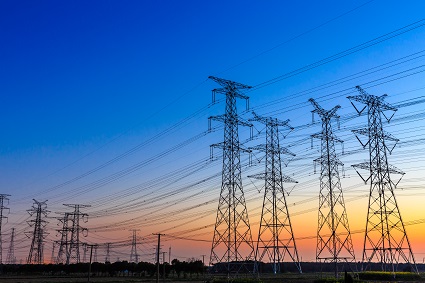
Understanding Electric and Natural Gas Charges
You likely glance at your energy bill each month, but do you really understand what you’re reading?
Utility bills can be confusing, as they tend to contain many abbreviations, numbers, and miscellaneous charges that most customers are unfamiliar with. While all utilities display information a bit differently, we decoded the sample energy bill below as an example. See the image and corresponding explanations for more details!

#1: Residential Gas Services: Natural gas usage information is listed first in this statement. Like this example, your bill may include a line of numbers beneath the heading. These numbers could indicate:
- Number of days in the current billing cycle (30 in this example)
- Dates in the billing cycle (May 30-June 29 in this example)
- Gas meter reading at the BEGINNING of the billing cycle (155) and at the END (165)
- Other numbers (“multipliers”) used by the utility for billing purposes
- Total number of therms you are being charged for in the billing cycle (12 in this example)
Q: What is a therm?
A: A therm is a unit of heat, equivalent to 100,000 Btu. It is the amount of heat required to raise the temperature of a pound of water by one degree Fahrenheit.
#2: Residential Distribution Service: Gas service provided to the customer under the utility’s service rate schedule. All utilities offer slightly different service rates, so check with yours if you’re unsure. Charges in this section include:
- System Connection and Customer Service Charge: Covers basic customer services such as billing, record-keeping, and information services, as well as a portion of the cost of being connected to the local gas delivery system. This utility calculates these charges on a daily basis.
- Distribution Service: Includes the process of transporting natural gas through the company’s facilities to the customer’s residence.

#3: Gas Supply Service: Charges associated with supplying natural gas to your residence. This can include:
- Administrative Charge: A small fee charged per therm of natural gas used that month, to provide gas supply to your residence.
- Natural Gas Service: The cost of your actual natural gas usage for the month.
- State and County Tax: Calculated by multiplying the total of all of the above charges by your local tax rate(s).
- Subtotal Gas Meter: The gas meter number assigned to you by the utility (269771 in this example). The subtotal to the right is the total for all natural gas services, including tax.
#3: Residential Electric Services Calculation: Electric usage information is detailed in this section, where “RG-1” stands for “Residential Grid Service.” Like this example, your bill may include a line of numbers beneath the heading, which could indicate:
- Number of days in the current billing cycle (30 in this example)
- Dates in the billing cycle (May 30-June 29 in this example)
- Electric meter reading at the END of the billing cycle (1491 on this bill)
- Electric meter reading at the BEGINNING of the billing cycle (976 on this bill)
- Other numbers (“multipliers”) used by the utility for billing purposes
- Total number of kilowatt-hours you are being charged for in the billing cycle (515 in this example)
Q: What is a kilowatt-hour (kWh)?
A: A kWh is the basic unit of electric energy, equal to one kilowatt of power supplied to or taken from an electric circuit steadily for one hour.
1 kilowatt = 1,000 watts. 1 kWh = 1,000 watt hours.
#5: Electric Service Details: Charges in this section may include:
- Grid Connection and Customer Service Charge: Covers the cost of services such as billing, record-keeping, and information services, as well as a portion of the cost of being connected to the local electricity grid.
- State Low-Income Asst. Fee: Many states offer energy assistance programs to help low-income individuals and families pay their utility bills and/or receive energy efficiency services.
- Distribution Service: Distribution includes the network of wires and equipment that carries electric energy from the transmission system to the customer's premises. The costs to support, operate, and maintain this local delivery system are included here at a cost per kilowatt-hour.

- Electricity Service: Covers the network of generating plants, wires, and equipment needed to produce or purchase electricity (generation) and to deliver it to the local distribution system (transmission). These costs are included here at a cost per kilowatt-hour.
- State and County Tax: Calculated by multiplying the total of the above electric charges (excluding the state low-income assistance fee) by your state tax rate.
- Subtotal Electric Meter: The electric meter number assigned to you by the utility (323604 in this example). The subtotal to the right is the total for all electric services, including tax.
The TOTAL charges for service for the month is the total of both your gas and electric usage.
We hope this article provided you with some useful insight when examining your energy bill next month!